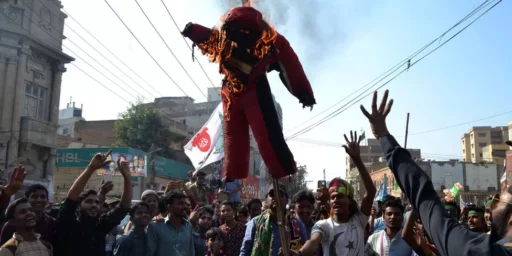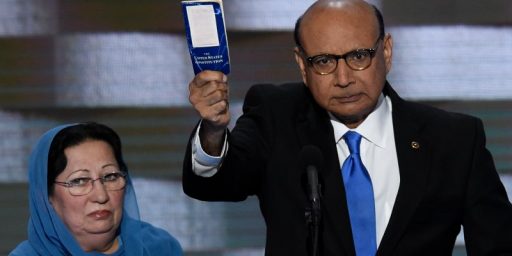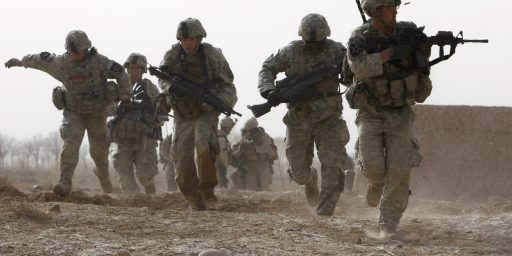Afghan Warlords Slowly Come In From The Cold
Today’s Wall Street Journal fronts a story about Afghan tribal leaders who have made the transition to bureaucrats in the new democratically elected government. While anecdotal, these accounts may point the way for the post-election transition in Iraq.
Afghan Warlords Slowly Come In From The Cold [$]
A year ago, Ismail Khan ruled northwest Afghanistan like a personal realm. His private army drilled at the foot of his hilltop mansion in Herat, the country’s most prosperous city. Envoys from Iran lavished him with aid. Even American troops in the area called him “Your Excellency.” Today, the man once dubbed “the Lion of Herat” sits behind a near-empty desk in Kabul fingering amber worry beads and signing documents. He is the country’s minister of power, but the only warmth in his shabby suite comes from a glowing space heater. His days as a mujaheddin commander are over, he says.
Mr. Khan has made the journey from feared warlord to bland bureaucrat thanks to the Bush administration’s gradual, flexible strategy for reconstructing Afghanistan since ousting the Taliban government in 2001. Rather than trying to force radical change overnight, the U.S. has been patient. It has avoided confrontations with tribal elders and warlords — letting them until recently keep their private militias and weapons and even paying the salaries of their fighters — while building a credible central government in Kabul.
[…]
In Mr. Khan’s case, U.S. military and diplomatic officials waited three years, until last September, before nudging him out. It happened after a rival warlord moved troops to the outskirts of Herat. To prevent a fight, the U.S. demanded the two forces separate and that Mr. Khan step aside peacefully and demobilize his troops. His reward: A cabinet job in Kabul. “I told him, ‘You can have a good, honorable life without having a militia, but you can’t have a militia and be our friend,’ ” said U.S. ambassador Zalmay Khalilzad, who flew to Herat to arrange the departure.
When the Americans arrived 3½ years ago, Afghanistan was a shattered country. Twenty years of conflict had left almost no infrastructure intact and its territory was carved up by powerful warlords, hostile to outsiders. Experts warned that the U.S., which has 18,000 troops in the country, would be lucky to do as well as the Soviets, who invaded Afghanistan in 1979 and retreated a decade later in defeat. Instead, the U.S. has fared much better, especially in the past six months. Afghans’ deep fatigue with war has helped but so has the slow U.S. approach. Warlords around the country are now peacefully ceding power to President Hamid Karzai’s government, which won national elections last October. The U.S. has trained a multiethnic military that is taking over security around the country.
This path contrasts sharply with the more aggressive approach the U.S. has tried in Iraq. There, the U.S. dismantled the Iraqi army and terminated the jobs of many Baath Party officials, a move creating thousands of powerful enemies that has fed the insurgency and frustrated Washington’s hopes for a rapid exit.
Expectations were so low for actually rebuilding Afghanistan that the U.S. occupation here proceeded with little interference from Washington and on a multiyear time frame unacceptable in Iraq, where the U.S. occupation authorities initially had much grander plans. “We call it salutary neglect,” Col. David Lamm, the chief of staff to the top U.S. general in Afghanistan, says of the relative inattention Afghanistan has received from Washington. “It’s been quite helpful.”
No one expects the U.S. to leave Afghanistan anytime soon. Many of the country’s problems are still far from solved: The economy remains a wreck. Living standards are among the world’s lowest. U.S. officials worry that Mr. Karzai could be assassinated, plunging the country into chaos. The illegal heroin trade is flourishing. And human rights groups are critical of the U.S. for supporting former warlords, arguing that they should face prosecution for sometimes brutal treatment of civilians during two decades of civil war.
This may well be the key difference with Iraq. Because Afghanistan has been almost forgotten by the press, and thus the public, the administration has been free to take a long term approach. Iraq, by contrast, is daily front page news and under a huge spotlight. Pressure to get it over with and bring the troops home is palpable. Both Afghanistan and Iraq are long term projects. It will be much harder to treat Iraq that way, though.






That’s some seriously lazy thinking there. Because of the press?
I’m not blaming the press, merely noting that the heavy attention to Iraq vis-a-vis Afghanistan changes the political dynamic. There’s clearly more pressure to get Iraq “done” quickly than in Afghanistan.
Great job the US has done,
However, the warlords are responsible for killing thousands of people (to be honest hundred of thousands) of people, destroyed their homes, made them get refuge in ‘unrefugeable’ places.
The US as a model of feedom and democracy has a moral duty to get those guilty to justice, that will prove that US really cares about justice and freedom in the region.
An Afghan in London